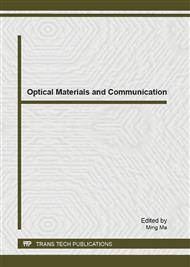[1]
A. G. Yarovoy, L.P. Ligthart, J. Matuzas, and B. Levitas, UWB radar for human being detection, IEEE Aerospace and Electronic Systems Magazine, Vol. 21, Issue 3, pp.10-14, Mar. (2006).
DOI: 10.1109/maes.2006.284354
Google Scholar
[2]
T. J. Li, M. M. Ge, G. W. Yuan, Human activity recognition using UWB radar and cameras on a mobile robot, 4th IEEE Conference on Industrial Electronics and Applications, pp.3038-3042, 25-27 May (2009).
DOI: 10.1109/iciea.2009.5138706
Google Scholar
[3]
C. Labarthe, J. P. Mutzig, B. Jecko, H. Hamieh, E. Martinod, N. Feix, J. M. Lalande, J. M. Denoual, J. M. Floch, V. Bertrand, R. Vergnault, P. Minvielle, F. Ducasse, An Ultra-Wideband radar concept for the detection of buried victims beneath building rubble, International Radar Conference on Surveillance for a Safer World, 2009., pp.1-6, 12-16 Oct. (2009).
DOI: 10.23919/eumc.2010.5616967
Google Scholar
[4]
Federal Communications Commission, Revision of Part 15 of the commission's rules regarding ultra-wideband transmission systems, FIRST REPORT AND ORDER, ET Docket 98-153, FCC 02-48, p.1–118, 14 February, (2002).
Google Scholar
[5]
J. D. Taylor, Introduction to Ultra-Wideband Radar Systems., Boca Raton, FL: CRC Press, (1995).
Google Scholar
[6]
M. Ghavami, L. B. Michael, R. Kohno, Ultra Wideband Signals and Systems in Communication Engineering., New York: Wiley, (2004).
DOI: 10.1002/0470867531
Google Scholar
[7]
R. Saxena, K. Singh Fractional Fourier transform: A novel tool for signal processing, J. Indian Inst. Sci., Jan- Feb 2005, vol. 85, pp.11-26.
Google Scholar
[8]
R. Tao, F. Zhan, Y. Wang, Fractional power spectrum, IEEE Trans. Signal Process., vol. 56, issue 9, p.4199–4206, Sep. (2008).
DOI: 10.1109/tsp.2008.925579
Google Scholar
[9]
Ran Tao, Bing Deng, Yue Wang, Research progress of the fractional Fourier transform in signal processing, Science in China (Ser. F, Information Science), vol. 49, issue 1, pp.1-25, Jun. (2006).
DOI: 10.1007/s11432-005-0240-y
Google Scholar
[10]
H. M. Ozaktas, O. Arıkan, M. A. Kutay, G. Bozdagı, Digital computation of the fractional Fourier transform, IEEE Trans. Signal Processing, vol. 44, p.2141–2150, Sep. (1996).
DOI: 10.1109/78.536672
Google Scholar
[11]
K. Yee, Numerical solution of initial boundary value problems involving Maxwell's equations in isotropic media, IEEE Trans. January (1989).
DOI: 10.1109/tap.1966.1138693
Google Scholar
[12]
D. A. Fleisch, A Student's Guide to Maxwell's Equations, Cambridge University Press, Cambridge, UK; New York, (2008).
Google Scholar
[13]
A. Taflove, S. C. Hagness, Computational electrodynamics: the finite-difference time-domain method, Boston, Artech House, (2000).
Google Scholar
[14]
S. D. Gedney, Introduction to the finite-difference time-domain (FDTD) method for electromagnetics, Synthesis lectures on computational electromagnetics, San Rafael, Calif., (2011).
DOI: 10.2200/s00316ed1v01y201012cem027
Google Scholar
[15]
D. M. Sullivan, Electromagnetic simulation using the FDTD method, IEEE Microwave Theory and Techniques Society, (2000).
Google Scholar


